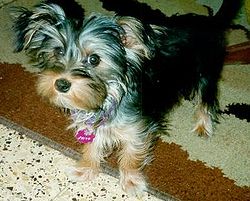| Revision as of 20:06, 8 April 2005 edit69.196.1.69 (talk) Added breed std. to apear (source AKC)← Previous edit | Revision as of 20:08, 8 April 2005 edit undo69.196.1.69 (talk)No edit summaryNext edit → | ||
| Line 46: | Line 46: | ||
| ==Appearance== | ==Appearance== | ||
| The breed standard calls for a long, blue and tan coat that |
The breed standard calls for a long, blue and tan coat that hangs straight and parts down the middle. However, many yorkies do not conform directly to the stardard. Some coats are black or grey on the body. Brown and gold on the faces and legs is most common. The fur in a ] is usually straight and can grow very long. Yorkies can also have somewhat wavy fur, although clubs do not recognize this variation for ]s. In either case, Yorkie fur is soft, fine, and high-maintenance, and must either be trimmed short or washed and brushed frequently. | ||
| ==Temperament== | ==Temperament== | ||
Revision as of 20:08, 8 April 2005
| Yorkshire Terrier | ||||||||||||
|---|---|---|---|---|---|---|---|---|---|---|---|---|
 | ||||||||||||
| Common nickname | ||||||||||||
| ||||||||||||
| Country of origin | ||||||||||||
| United Kingdom | ||||||||||||
| Classification | ||||||||||||
| ||||||||||||
| Breed standards (external links) | ||||||||||||
| FCI, AKC, ANKC, KC(UK), NZKC |
The Yorkshire Terrier, also known as a Yorkie, is a breed of small dogs, one of many toy dog breeds. Yorkies can be very small indeed, usually not weighing more than about 5 or 6 pounds (less than 3kg.)
Appearance
The breed standard calls for a long, blue and tan coat that hangs straight and parts down the middle. However, many yorkies do not conform directly to the stardard. Some coats are black or grey on the body. Brown and gold on the faces and legs is most common. The fur in a show dog is usually straight and can grow very long. Yorkies can also have somewhat wavy fur, although clubs do not recognize this variation for dog shows. In either case, Yorkie fur is soft, fine, and high-maintenance, and must either be trimmed short or washed and brushed frequently.
Temperament
Unlike some other small breeds (such as the Toy Poodle or Pomeranian), Yorkies seem to recognize the limitations of their size, and are almost never aggressive. Yorkie personalities vary greatly apart from this, and they might be docile lap dogs or yappy and endlessly playful.
Yorkies typically get along well with cats or other dogs, and love to play together in groups. However, they are still terriers, and even an old, sedentary lap dog will eagerly hunt rodents. Because they are so small, they are easily injured, so while they will get along very well with children, it can be dangerous for the Yorkie to keep it in a house with small or abusive children. Also, despite their small size, if continually provoked or if attacked, like all dogs, they pack a surprisingly powerful bite.
Yorkies may seem rather vapid and unintelligent at times (perhaps due to their yapping and playfulness), but they can easily be trained to perform simple tasks.
Health
Yorkies tend to develop cataracts in their old age, but their small size limits the effects of conditions such as arthritis. There is also the possibility of Trachea collapse, the cause of which is thought by many to be genetic. As with many purebred dogs, the Yorkshire Terrier is prone to certain genetic disorders. Most common is the liver shunt (portosystemic shunt). In this condition some of the dog's blood bypasses the liver and as such does not get cleaned of those toxins that the liver is responsible for removing. A Yorkie with this condition might exhibit some or all of the following symptoms: small stature, poor muscle development, behavioral abnormalities, unresponsiveness, seizures, and so on. However, if treated by a veterinarian, in time, the condition is most often reversible.
A newly proposed breed, the Biewer, might or might not be a variation of the Yorkie or an entirely new breed.
Category: